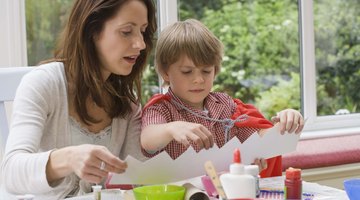The Best Color Combinations for a Craft Room
Use a little color psychology to pick a color scheme for a craft room and, possibly, improve your crafting abilities. In order for color to successfully influence your mindset while working in the craft room, the colors you choose do not have to saturate the craft room, according to "Psychology Today"

magazine expert, Dr. Juliet Zhu. Walls can remain a neutral color like white, cream, tan or brown to incorporate color into the room more subtly. Even working with colored scissors can have an impact.
Red and Blue
The best color combination is red and blue, according to "Psychology Today" magazine. Researchers at the University of British Columbia, Sauder School of Business, including Dr. Zhu, tested participants by having them perform computer tasks with different background colors, including white as a control. The results indicated an association with details for red and creativity for blue backgrounds.
Use red and blue to balance the different ways you think about crafts. Red influences attention to detail. Blue, on the other hand, influences creativity. The color that is used most in the room depends on the what types of crafts you work on and which ones you see yourself and best or worst at. Knitting, for instance, is a very detailed craft. Designing your own knitting patterns or altering knitting patterns, on the other hand, requires both creativity and attention to detail. Red and blue might spread equally throughout the craft room of a knitting pattern design buff.
Warm and Cool
Red is a what is called a "warm" or "hot" color. Blue is a "cool" or "cold" color. Other warm colors include orange and yellow. In addition to blue, cool colors include green and teal. Combining these colors provides a more balanced effect. Or, try purple. Purple is the color that results when red and blue are put together.
Warm Colors
Warm colors alone can be a great choice for a warm and cozy craft room. Colors like red, orange and yellow can be combined for a room that provides energy and attention to detail. Warm color combinations can actually make a room feel physically warmer, according to "The Complete Color Harmony" book. Red, yellow and orange make things stand out and actually stimulate neurological activity. Warm colors increase heart and breath rates when they are viewed. Using warm colors alone might not be a good idea if you get easily frustrated when you mess up a craft project.
Cool Colors
Using cool colors in combination without any warm colors makes for a crafting oasis. Cool colors are considered relaxing. To make a room outfitted in cool colors even more relaxing and maximize your creative attributes, use varying shades of blue. Light or pale colors like pale blue provide a more relaxing effect than darker colors, according "The Complete Color Harmony." In addition to enhancing creativity with use of the color blue, cool colors are a good choice for someone who uses crafting to relax.
References
- "Psychology Today": What Color Could You Use More Of?
- "The Complete Color Harmony: Expert Color Information for Professional Color Results"; Tina Sutton and Bride M. Whelan; 2004
Resources
Writer Bio
Josalin Mitchell began her writing career in 2009. She has written web content as well as grants, training manuals, reports and brochures for nonprofit agencies. Mitchell has a Bachelor of Arts in English and women's studies and is currently pursuing a Master of Arts in Teaching in English education.
Photo Credits
- Jupiterimages/BananaStock/Getty Images
- Jupiterimages/BananaStock/Getty Images
More Articles



